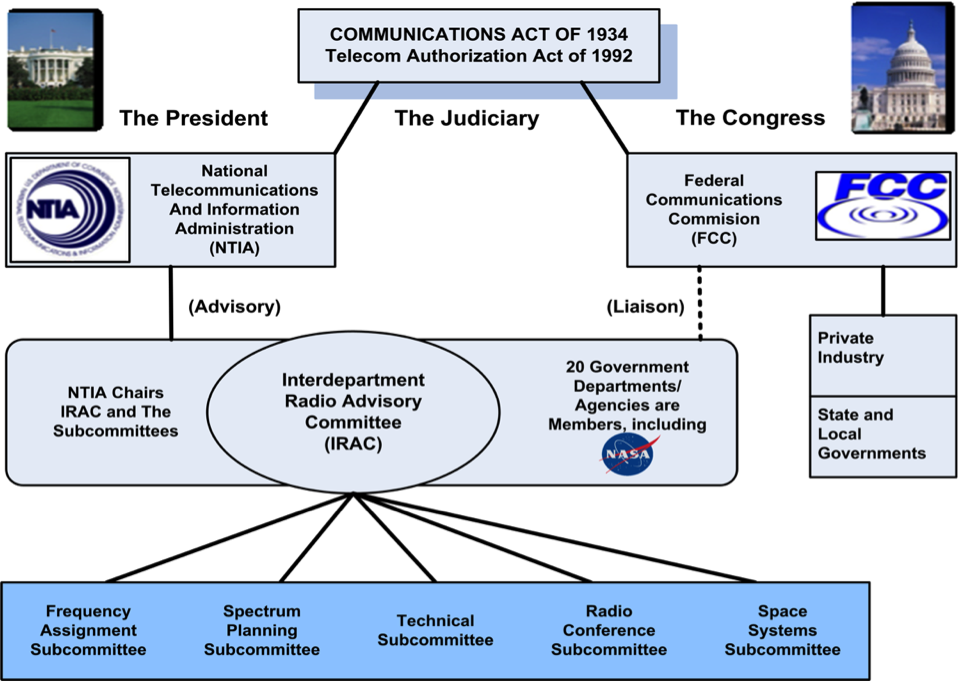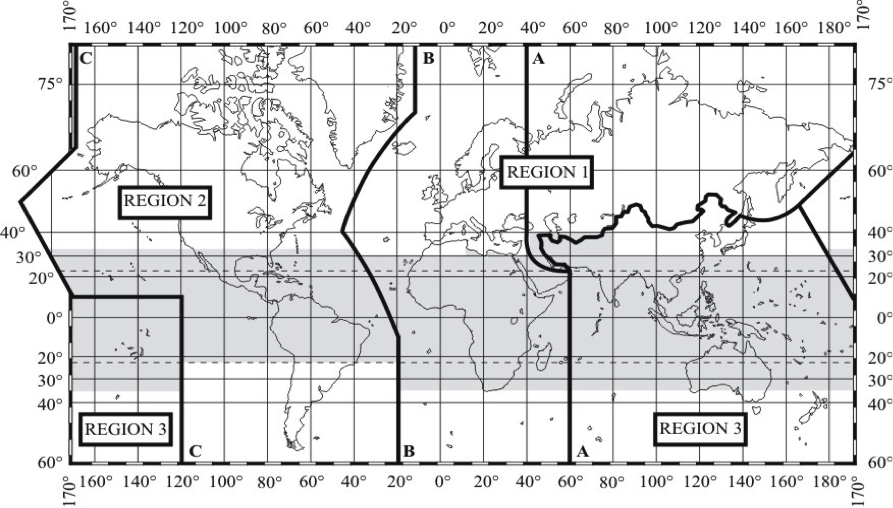
Procedural
Requirements
Effective Date: September 22, 2014
Expiration Date: September 22, 2026

|
NASA Procedural Requirements |
NPR 2570.1C Effective Date: September 22, 2014 Expiration Date: September 22, 2026 |
| | TOC | ChangeHistory | Preface | Chapter1 | Chapter2 | Chapter3 | Chapter4 | Chapter5 | AppendixA | AppendixB | AppendixC | AppendixD | AppendixE | AppendixF | AppendixG | AppendixH | AppendixI | AppendixJ | AppendixK | AppendixL | ALL | |
This NPR provides guidance in the identification and use of radio frequency (RF) electromagnetic (EM) spectrum for Agency communications links and remote-sensing purposes. The NPR addresses radio frequency interference procedures and defines requirements for the support of future NASA programs with long-lead-time spectrum management initiatives. NASA personnel responsibilities are defined in Chapter 2. 1
1.2.1 The U.S. policy, with regard to the use of properly authorized frequency bands, is stated in 47 U.S.C. 151 § et seq., as amended and 47 U.S.C. § 901 et seq. In addition to these Acts, the 47 U.S.C. § 701 et seq, as amended, is applicable for satellite systems. NASA has derived policies from the U.S. policy which is to be adhered to by all Agency spectrum users as given in NASA Policy Directive (NPD) 2570.5, and the document hierarchy is outlined in Appendix C.
1.2.2 All RF spectrum usage by NASA programs and projects will be pursuant to specific assignments approved by the NASA Spectrum Manager and the Associate Administrator for HEOMD, under the conditions specified in this NPR Chapter 3, Section 3.7.
1.2.3 All missions, programs, projects, and other activities, requiring use of the EM spectrum, need to consider their spectrum requirements at each review in a project's life cycle and to submit requests for spectrum certification as early in the acquisition and procurement cycles as possible to ensure that missions receive the necessary authorizations and certifications to operate.
1.2.4 Funds cannot be obligated for formal engineering (as determined by the Center Director), development and testing, or procurement of operational EM-radiating or receiving devices until spectrum certifications have been approved by the NTIA and the approval is provided to the appropriate program, project office, and the Center/Facility SM.
1.2.5 Requests for spectrum certification for the development or procurement of major communications-electronics systems need to include cost estimates and economic alternatives when submitted to NTIA in accordance with national policy ((OMB) Circular A-11) (see Appendix D).
1.2.6 NASA mission requirements will be met by using the EM spectrum as efficiently as practical, which may be by the design, the use of advanced spectrum-efficient technologies (e.g., software-defined radios, cognitive radios, smart antennas) or advanced modulation and coding techniques.
1.2.7 All missions, programs, projects, and other activities will use frequency bands that are properly allocated for their intended use. Use of other frequencies will only be granted on a case by case basis.
1.2.8 All spacecraft will be able to remotely or directly cease EM emissions. A spacecraft that has an automatic capability to cease transmissions may be granted a waiver of this requirement.
1.2.9 No NASA space missions will be allowed to transmit in exclusive passive radio frequency (RF) bands allocated, either nationally or internationally, to the radio astronomy service, the Earth exploration- satellite service (passive), or the space research service (passive).
l.2.10 The Goddard Space Flight Center (GSFC) SM, working with the respective mission Center's SM, is responsible for frequency selection for NASA missions requiring use of 2025-2110 MHz or 2200-2290 MHz.
1.2.11 The Jet Propulsion Laboratory (JPL), a Federally Funded Research and Development Center, SM, in working with the respective mission Center's SM, is responsible for the frequency selection for NASA and Space Frequency Coordination Group members' deep space missions.
1.2.12 The Johnson Space Center SM, working with the applicable Center's SM for NASA network support, is responsible for the frequency selection and protection
requirements for all NASA human spaceflight activities.1.3.1 Within the United States and its Possessions, the RF EM spectrum is further allocated to non-Federal and Federal users. The FCC is responsible for the allocation and assignment of frequencies to non-Federal users (see http://www.fcc.gov), and the NTIA is responsible for the allocation and assignment of frequencies to departments and agencies of the U.S. Government (see http://www.ntia.doc.gov). The NTIA performs its functions through the assistance of the Interdepartment Radio Advisory Committee (IRAC) 2 that is also responsible for maintaining the National Table of Frequency Allocations (see Figure 1-1). 3 Coordination between non-Federal and Federal users of the RF EM spectrum is accomplished through correspondence and, if necessary, joint meetings of the FCC and the NTIA.
2 The IRAC has been in session continuously since 1922; NASA has been an active member since 1958.
3 See Chapter 4 of Manual of Regulations and Procedures for Federal Radio Frequency Management. (NTIA Manual).
1.3.2 The Department of State is responsible for coordinating United States participation in international fora where spectrum management issues are addressed.
1.3.3 Internationally, the RF EM spectrum is allocated by the International Telecommunication Union (ITU) (see http://www.itu.int/) to various classes of service according to different regions of the world (see Figure 1-2).
 Figure 1-1 United States (US) National Spectrum Management Structure 4
Figure 1-1 United States (US) National Spectrum Management Structure 4
4 The IRAC member agencies are: Department of Agriculture, Department of the Air Force. Department of the Army, Broadcasting Board of Governors, U.S. Coast Guard, Department of Commerce, Department of Energy, Federal Aviation Administration, Department of Homeland Security, Department of Justice, National Aeronautics and Space Administration, National Science Foundation, Department of the Navy, Department of State, Department of Transportation, Department of the Treasury, U.S. Postal Service, Department of Veterans Affairs, FCC Liaison.
 Figure 1-2 Geographic Regions for Frequency Allocation of the Spectrum
Figure 1-2 Geographic Regions for Frequency Allocation of the Spectrum
The mission of the NASA Spectrum Management Program, as directed by NASA Policy Directive (NPD) 2570.5, is to ensure that sufficient high-quality radio frequency EM spectrum is available in a timely manner to enable the success of NASA's missions. The Spectrum Management Program ensures that all NASA activities comply with national and international rules and regulations applicable to the use of the electromagnetic spectrum and facilitates securing spectrum and orbital resources (both domestically and internationally) needed to enable aeronautical and space mission requirements. The Spectrum Management Program supports the vital work of all NASA Mission Directorates.
| TOC | ChangeHistory | Preface | Chapter1 | Chapter2 | Chapter3 | Chapter4 | Chapter5 | AppendixA | AppendixB | AppendixC | AppendixD | AppendixE | AppendixF | AppendixG | AppendixH | AppendixI | AppendixJ | AppendixK | AppendixL | ALL | |
| | NODIS Library | Legal Policies(2000s) | Search | |
This document does not bind the public, except as authorized by law or as incorporated into a contract. This document is uncontrolled when printed. Check the NASA Online Directives Information System (NODIS) Library to verify that this is the correct version before use: https://nodis3.gsfc.nasa.gov.